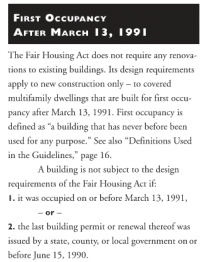Yikes
Gold Member
A key concept for for whether an existing building with housing needs to be adaptable is when it was "constructed for first occupancy" (CBC 1102A.2, 11B-233.3.4.3).
I have a building that got its permit in 1990 and got C of O in May of 1991. I'm talking with a building official who says his department's policy is to only use the date of the Certificate of Occupancy to establish the applicable code requirements. I disagree, and I want your opinion on my argument. First let's look at the verbs:
1. The CBC does not say: "occupied on or before 3/13/1991", and it does not say "issued a Certificate of Occupancy on or before 3/13/1991".
2. It says "CONSTRUCTED for first occupancy on or before 3/13/1991". The active verb (that vests the applicable requirement) is CONSTRUCTION.
3. When applying a building code (not FHA), the applicable code is usually established as the date of plan check submittal. I can't imagine a building department issuing a permit in 1990, the building is ready for final inspection by 3/12/1991, but the inspector can't be there until 3/14/1991, and now suddenly the whole building needs to be altered to meet California adaptability requirements.
For what it's worth, the Fair Housing Act Design Manual defines this phrase on page 12 (excerpt below), but the California Building Code does not, even though they both reference the same date of March 13,1991:
Notice that FHA gives grace in item 2 for buildings that were already permitted prior to 6/15/1990. - - that's my building!


